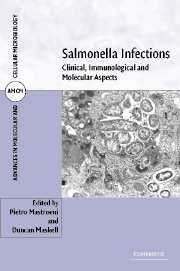Book contents
- Frontmatter
- Contents
- List of contributors
- Preface
- 1 Epidemiological and clinical aspects of human typhoid fever
- 2 Antibiotic resistance in Salmonella infections
- 3 Host-specificity of Salmonella infections in animal species
- 4 Public health aspects of Salmonella enterica in food production
- 5 The Salmonella genome: a global view
- 6 Pathogenicity islands and virulence of Salmonella enterica
- 7 In vivo identification, expression and function of Salmonella virulence genes
- 8 Mechanisms of immunity to Salmonella infections
- 9 Interactions of S. enterica with phagocytic cells
- 10 Interactions between Salmonella and dendritic cells: what happens along the way?
- 11 Immunity to Salmonella in domestic (food animal) species
- 12 Newer vaccines against typhoid fever and gastrointestinal salmonelloses
- 13 S. enterica-based antigen delivery systems
- Index
- Plate section
- References
13 - S. enterica-based antigen delivery systems
Published online by Cambridge University Press: 04 December 2009
- Frontmatter
- Contents
- List of contributors
- Preface
- 1 Epidemiological and clinical aspects of human typhoid fever
- 2 Antibiotic resistance in Salmonella infections
- 3 Host-specificity of Salmonella infections in animal species
- 4 Public health aspects of Salmonella enterica in food production
- 5 The Salmonella genome: a global view
- 6 Pathogenicity islands and virulence of Salmonella enterica
- 7 In vivo identification, expression and function of Salmonella virulence genes
- 8 Mechanisms of immunity to Salmonella infections
- 9 Interactions of S. enterica with phagocytic cells
- 10 Interactions between Salmonella and dendritic cells: what happens along the way?
- 11 Immunity to Salmonella in domestic (food animal) species
- 12 Newer vaccines against typhoid fever and gastrointestinal salmonelloses
- 13 S. enterica-based antigen delivery systems
- Index
- Plate section
- References
Summary
INTRODUCTION
Salmonella enterica has been proposed as a highly efficient vector for the delivery of heterologous molecules to the immune system of the host. For more than two decades recombinant live attenuated salmonellae expressing antigens from other pathogens have been extensively assessed as oral multivalent vaccines and tested in a great diversity of experimental models. More recently, it has been demonstrated that S. enterica can also be used as a vector for DNA vaccines. New emerging applications for recombinant S. enterica include its use in the treatment of cancer and possible applications in gene therapy.
Some distinctive features of S. enterica have strongly contributed to make it an attractive delivery system. Among them are features of the immunobiology of S. enterica infections and the genetics of the bacteria. S. enterica naturally enter the host by the oral route, elicit strong mucosal and systemic immune responses and are eventually cleared from the tissues leaving long lasting immunological memory. Once inside the host, S. enterica can be found within macrophages and dendritic cells (DC), which are professional antigen presenting cells (APC). Thus, oral administration of recombinant S. enterica can be an effective way of directing the expression of relevant molecules (antigens or immunomodulatory molecules) to APC.
The genetics of S. enterica are very similar to those of E. coli and the full genome sequences of several Salmonella species and serovars are available. Therefore, the molecular tools and techniques currently available enable the rational construction of vaccine vectors based on S. enterica.
- Type
- Chapter
- Information
- Salmonella InfectionsClinical, Immunological and Molecular Aspects, pp. 337 - 370Publisher: Cambridge University PressPrint publication year: 2006



